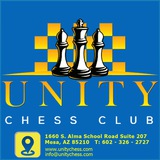when Kan concluded that Black is just fine with two pawns for the exchange, the pair of bishops and a superior pawn structure, and White should play accurately to maintain the balance. In the game, Ufimtsev was not up to the task, and Kan won, thus qualifying for the USSR Championship.
Now, White has a powerful knight on a strong square against Black’s darksquared bishop. The bishop is not a traditionally bad one, due to the pawn structure, but it has no real use or target for now. Korneev brought home the win when the pressure became too much for the weak b6-pawn:
26…♗g7 27.♖ab1 ♕d7 28.♕b5 ♕b7 29.b4 ♖e5 30.c4 ♖e2 31.bxc5 dxc5 32.a5 ♗d4 33.♕xb6 ♕xb6 34.axb6 … 1-0 (63)
Unity Chess Club
Jack Easton-Irina Krush Philadelphia 2018 Should White go for the queen exchange or grab on b7?
No queen exchange! The black kingside pawns are on the wrong color, and so the presence of queens gives White excellent attacking chances, due to the opposite-coloured bishops. Tactics fail to compensate for that here: 35.♕xb7 ♕xa3 36.♖xc4, when 36…♗xe3 can be met by the cool 37.♕f7, for example: 37…♕a6 (37…♗xf2+ 38.♔g2!) 38.♗e4 ♗g5 39.h4 ♗f6 40.♕g6 ♔g8 41.♖c6.
Here, White is also a pawn up and is also clearly better, but the technical task is much more difficult. With the queens on, just creating mating threats would have done it. Krush even achieved a theoretically-drawn position when White exchanged the rooks … ½-½ (71).
You may also have been tempted by sacrifices on g4, but this thematic central break against White’s Maroczy formation is just fine, especially as White’s king is still lingering in the middle. Still, the lines are not at all easy in this case.
14.g5 is complicated: 14…dxe4 15.gxf6 ♘xf3+ 16.♗xf3 (16.♔f1 ♗xf6) 16… exf3 17.fxe7 ♖xe7 18.♘e4 ♗f5, winning back material.
